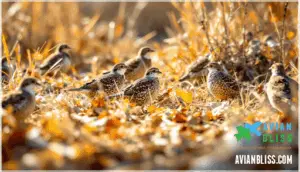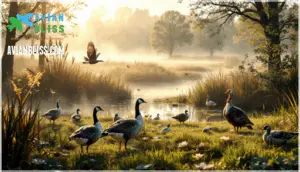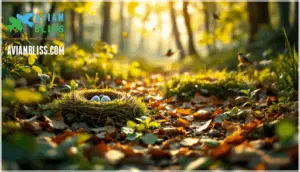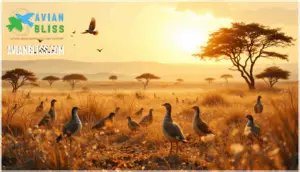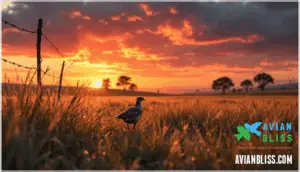This site is supported by our readers. We may earn a commission, at no cost to you, if you purchase through links.

Unlike songbirds that retreat to treetops or raptors that soar beyond reach, these species have evolved to thrive at ground level, where powerful legs outmatch wings and camouflage trumps flight. From quail exploding into short bursts when startled to turkeys sprinting through underbrush at 25 miles per hour, ground birds have traded the freedom of sustained flight for specialized adaptations that make them masters of their earthbound domain.
Understanding what defines these birds—and how they differ from species that simply nest on the ground—reveals a fascinating branch of avian evolution shaped by predation, habitat, and the ecological niches they fill.
Table Of Contents
- Key Takeaways
- What Are Ground Birds?
- Common Types of Ground Birds
- Habitats and Nesting Strategies
- Ecological Importance of Ground Birds
- Threats and Conservation of Ground Birds
- Frequently Asked Questions (FAQs)
- Where do ground birds live?
- What birds nest on the ground?
- How do ground birds breed?
- What is a ground nesting bird?
- How many birds nest on the ground?
- How do ground nesting birds choose their nesting sites?
- What kind of birds live on the ground?
- What kind of bird runs on the ground?
- What kind of birds nest on the ground?
- What kind of bird digs holes in the ground?
- Conclusion
Key Takeaways
- Ground birds have evolved specialized physical adaptations—including legs 42% longer than tree-dwelling relatives, wings reduced to under 15% of flying cousins’ length, and beaks 20–35% larger for soil probing—that prioritize terrestrial survival over aerial escape.
- These species play critical ecological roles by dispersing over 1,200 seeds per hectare across distances exceeding 400 kilometers, returning nutrients that boost soil fertility by up to 20%, and sustaining over 70% of native tree species in temperate forests.
- Ground bird populations face compounding threats from habitat fragmentation, agricultural pesticides that weaken eggs, and climate change effects that increase nest predation by 25–38% since 1950 while disrupting predator-prey dynamics.
- Conservation success depends on protecting habitat corridors that connect breeding grounds, supporting restoration projects through community engagement, and adopting sustainable yard practices like reducing pesticides and preserving native grasslands.
What Are Ground Birds?
Ground birds aren’t just a single type—they’re defined by how they live and move through the world. Some spend their entire lives walking, running, and foraging on land, while others simply choose the earth as their nesting site.
Let’s break down what sets these birds apart, from their core traits to the physical tools that keep them thriving on solid ground.
Definition and Key Characteristics
Ground birds are defined by behavior more than breeding alone, spending most of their lives walking, running, and foraging on land rather than perching high. These exceptional ground nesters possess specialized Ground Adaptations that help them thrive where others can’t.
Their Ground Bird Characteristics include:
- Strong legs and sharp claws built for defense and rapid movement
- Camouflage-friendly plumage that provides Bird Camouflage against predators
- Short wings optimized for quick bursts rather than sustained flight
- Unique Feather Characteristics and Leg Structure designed for terrestrial life
- Simple Nesting Behaviors using shallow depressions or natural cavities
These Ground Nesting Species represent nature’s masters of terrestrial survival. They often rely on effective ground nesting strategies to protect themselves from predators.
Ground-Dwelling Vs. Ground-Nesting Birds
You might assume all ground birds share the same lifestyle, but there’s actually a meaningful split between those who simply nest low and those who’ve committed their entire existence to the earth. Ground-nesting birds like warblers and thrushes use Ground Nesting Strategies temporarily, returning to trees for foraging and Bird Migration.
True Ground Dwelling species—quail, pheasants, roadrunners—have evolved distinct Foraging Habits and Bird Nesting Habits centered entirely on terrestrial life, rarely taking flight.
Physical Adaptations for Ground Life
What separates these earthbound specialists from occasional ground visitors? The answer lies in their bodies. Over generations, Ground Dwelling species have traded aerial prowess for terrestrial mastery through measurable shifts in Leg Structure, Feather Loss, and Body Mass.
Ground-dwelling birds traded flight for terrestrial mastery, evolving specialized legs, reduced feathers, and increased body mass over generations
Physical traits tell the story:
- Legs built for distance: Ground-nesting birds like larks show tarsometatarsus bones 42% longer than tree-dwelling cousins, while ostriches sprint past 70 km/h on powerhouse limbs.
- Wings that whisper goodbye: Flight feather length in ratites has shrunk to under 15% of flying relatives, redirecting energy toward camouflage and durability.
- Beaks shaped by diet: Ground feeders possess 20–35% larger beak surface area for probing soil, plus reinforced skulls in species like guinea fowl that forage headfirst into rocky terrain.
You’ll notice skin texture differences too—callused toes resist abrasive ground, while cryptic plumage mimics leaf litter. These ground nesting strategies and bird nesting habits aren’t coincidences; they’re survival written in bone and feather. As birds adapt to changing environments, they exhibit climate change effects that influence their physical traits and behaviors.
Common Types of Ground Birds
Ground birds come in surprisingly diverse forms, from the plump quail scratching through leaf litter to the elegant sandpiper probing mudflats at dawn. You’ll find these species across nearly every habitat type, each adapted to life on the earth’s surface in fascinating ways.
Let’s explore the major groups you’re most likely to encounter in the field.
Quail and Bobwhites
Quails and bobwhites are masters of disappearing in plain sight, blending into grasslands and brushy edges where they nest directly on the ground. The northern bobwhite, stretching about 10 inches long with a 15-inch wingspan, thrives in central and eastern United States habitats rich with cover. You’ll find these plump, short-tailed ground birds scratching through leaf litter, feasting on seeds and insects that make up their omnivorous diet. Female bobwhites lay 8 to 13 eggs in shallow ground nests, incubating them for 17 to 20 days before chicks emerge ready to follow their parents.
Despite their adaptability, bobwhite populations have crashed by roughly 85 percent over the past 50 years, making bird conservation and wildlife conservation efforts critical for their survival. With about 130 quail species worldwide and 47 wild species distributed across continents, these ground-nesting birds face mounting pressures from habitat loss and environmental changes. Unlike true migratory species, quail migration patterns are minimal—most populations remain resident year-round, relying on local habitat quality for their persistence.
| Characteristic | Details |
|---|---|
| Average Lifespan | Approximately 2 years in the wild |
| Clutch Size | 8 to 13 eggs per nesting attempt |
| Primary Habitat | Grasslands, brushy pastures, woodland edges |
| Diet Composition | Seeds from cereal crops, insects, larvae |
| Population Trend | 85% decline in bobwhites over 50 years |
Wild Turkeys and Grouse
Wild turkeys and ruffed grouse may strut and drum with theatrical flair, but their survival depends on the unassuming nests they scratch into forest floors and field edges.
Female wild turkeys lay around 8 eggs in shallow depressions under shrubs, relying on feather camouflage to avoid detection in turkey habitat. Ruffed grouse behavior shows similar ground nesting patterns, with hens incubating eggs beneath small trees while wild foraging for insects and seeds keeps these ground birds thriving in diverse ecosystems where wildlife conservation matters most.
Shorebirds and Waders (e.g., Killdeer, Sandpipers)
Killdeer, sandpipers, and their shorebird cousins don’t bother with tree branches—they trust the open ground near water’s edge, where a well-placed nest can mean the difference between survival and catastrophe.
You’ll find killdeer laying eggs in shallow depressions across coastal habitats and wetlands, while sandpipers scrape out nests along shorelines during their migratory patterns.
Shorebird nesting depends on camouflage and timing, with wading birds synchronizing egg-laying to bird migration cycles that support wetland conservation and healthy shorebird behavior.
Waterfowl and Game Birds
Ducks, geese, and turkeys stake their claim to survival by building nests right on the ground, turning open terrain into nurseries where vigilance and instinct outweigh the comfort of elevation. These waterfowl and game birds rely on ground nesting strategies shaped by bird migration patterns and wetland management practices that safeguard wildlife habitat.
- Canada Geese nest in grassy areas near water, timing reproduction with seasonal movements
- Ducks construct concealed nests using vegetation to protect clutches from avian diseases and predators
- Wild Turkeys depend on forest floor cover, their populations monitored through hunting regulations and feather conservation efforts
Songbirds That Nest on The Ground
While most songbirds build their nests in the safety of branches overhead, a surprising number of warblers and thrushes gamble on ground-level real estate, relying on stealth and camouflage instead of height. These ground-nesting birds adapt their breeding habits and foraging strategies to survive where songbird migration routes intersect with predator-rich terrain.
| Species | Nest Architecture |
|---|---|
| Ovenbird Warbler | Dome-shaped structure with side entrance, built from leaves and grasses near dense vegetation |
| Hermit Thrush | Cup nest in low vegetation, lined with mosses for insulation and concealment |
| Wilson’s Warbler | Moss and grass construction with fur or feather lining in shrubs or ground depressions |
Ground-dwelling songbirds that nest on the ground demonstrate how birds adapt nest site selection to available cover rather than elevation.
Habitats and Nesting Strategies
Ground birds don’t just live on the ground—they build their futures there too. Where they nest and how they raise their young depends on the landscape around them and the threats they face.
Let’s look at the habitats they choose and the survival strategies that keep their eggs and chicks safe.
Grasslands, Forests, and Wetlands
Ground birds don’t just pick any spot to call home—they’ve evolved to thrive in three distinct landscapes, each offering unique survival advantages. Here’s where habitat diversity meets avian ecology:
- Grasslands and savannas shelter quail and pheasants among tall grasses
- Forests provide cover for grouse and turkeys beneath dense canopy
- Wetlands support sandpipers and killdeer near water sources
- Wildlife corridors connect biodiversity hotspots, enabling ground nesting birds to access ecosystem services
Strategic land management preserves these critical wildlife habitats.
Nest Site Selection and Construction
Choosing the right piece of real estate can mean life or death when you’re raising chicks on the ground—so these birds approach nest site selection with the precision of a military strategist scouting terrain. Ground nesting birds prioritize concealment over comfort, selecting sites beneath bushes or within dense vegetation.
Nest architecture remains deliberately simple—shallow depressions lined with grasses, leaves, and available nesting materials. Species like quail construct burrows or scrapes, while plovers rely on minimal nest construction, letting egg camouflage and site selection shoulder the defensive burden.
Camouflage and Predator Avoidance
Beyond picking the perfect spot, you’ve got to make sure predators can’t find you in the first place. Ground nesting birds rely heavily on camouflage techniques—pattern matching matters more than color alone, with clutch survival directly linked to how well eggs blend with the substrate.
Disruptive feather patterns and adaptive coloration keep over 85% of ground nesters hidden from aerial predators. When camouflage fails, bird behavior kicks in: plovers flush at longer distances if their eggs aren’t well-concealed, while shorebirds fake injuries to lead threats away from nest concealment zones.
Egg Laying and Chick Rearing
Once those eggs hit the ground, you’re playing a numbers game—clutch size varies by species, with quail laying up to 14 eggs while plovers settle for just 3 or 4. Incubation periods also differ significantly, stretching from 18 days in killdeer to nearly a month for turkeys.
Chick development follows two distinct paths: precocial young, like sandhill cranes, are able to walk within hours of hatching. In contrast, parental care intensity plays a crucial role in determining fledgling success for ground-nesting birds navigating predator-rich landscapes.
Ecological Importance of Ground Birds
Ground birds aren’t just fascinating to watch—they’re essential players in keeping ecosystems balanced and thriving. From spreading seeds across landscapes to controlling pest populations, these birds shape the environments they call home.
Let’s explore three key ways ground birds support the natural world around you.
Seed Dispersal and Nutrient Cycling
You’re witnessing ecosystem balance in action when ground birds move through their territories. These species drive biodiversity preservation through critical ecological processes that sustain wildlife biology far beyond their immediate presence. Consider their contributions to avian ecology studies:
- Seed dispersal patterns move plant genetics across landscapes—some birds scatter over 1,200 seeds per hectare, with migration extending dispersal distances beyond 400 kilometers.
- Nutrient cycling returns nitrogen and phosphorus to soils through droppings, boosting soil fertility by up to 20% in foliar nutrients where bird populations thrive.
- Ecological balance maintains plant regeneration, as bird-mediated dispersal sustains over 70% of native tree species in temperate forests.
- Bird migration connects habitats, with gut passage times processing seeds in under two hours before depositing them in nutrient-rich conditions.
This interplay shapes ecosystem balance and biodiversity across grasslands, wetlands, and forests.
Insect and Pest Control
The same birds that scatter seeds across your backyard also devour hundreds of insects weekly, functioning as natural pest regulators in agricultural and wild landscapes. Roadrunners and guineafowl excel at biological control, targeting grasshoppers, beetles, and crop-damaging invertebrates through insect ecology interactions.
This pest management reduces agricultural losses while supporting ecosystem balance. Wildlife conservation efforts protecting ground-nesting birds simultaneously preserve these avian ecology studies, which reveal critical wildlife biology services that maintain ecological balance and biodiversity preservation across diverse habitats.
Role in Food Chains and Biodiversity
As prey, predator, and seed disperser, ground birds create trophic connections that ripple through entire ecosystems and sustain biodiversity. Their foraging behaviors support nutrient cycling and ecosystem engineering, making them essential biodiversity indicators.
Hawks and foxes rely on these bird species as primary food sources, while food web dynamics shift when populations decline. Protecting ground nesting birds through avian conservation preserves these species interactions and the ecological importance of ground birds across habitats.
Threats and Conservation of Ground Birds
Ground birds face mounting pressures that put their survival at risk. From disappearing grasslands to shifting weather patterns, these threats demand our attention and action.
Here’s what’s pushing ground birds toward the edge—and what you can do to help turn things around.
Habitat Loss and Fragmentation
When habitat destruction fractures your landscape into isolated patches, ground nesting birds lose safe breeding zones and access to critical resources. Fragmentation effects force these species into smaller territories where predators and ecosystem disruption intensify.
Conservation strategies now prioritize wildlife corridors connecting remnant habitats, allowing birds to disperse between breeding grounds. Habitat preservation methods targeting grasslands and wetlands prove essential for maintaining bird habitat and distribution patterns critical to ecological conservation.
Agricultural and Human Impacts
From tractor blades to sprawling suburbs, your footprint reshapes ground bird survival in ways both obvious and invisible. Agricultural pollution from pesticides weakens eggs and disrupts reproduction, while intensive farming erases nesting cover through land use changes.
Human disturbance from recreation and development fragments remaining habitats, accelerating ecosystem degradation.
Wildlife conservation efforts must balance food production with habitat preservation to counter these mounting threats to ground bird populations.
Climate Change and Predation
Rising temperatures aren’t just warming the planet—they’re rewriting predator-prey relationships for Ground Nesting Birds in ways that accelerate Threats to Ground Bird Populations. Temperature Effects intensify nest predation through multiple pathways:
- Warmer climates increase predator activity, with nest survival decreasing as mean temperatures rise across temperate regions
- Extreme weather events expose vulnerable nests, with heat and rainfall reducing reproductive success by 25–38% since 1950
- Shifting predator abundance disrupts temporal refuges, as warmer conditions dampen rodent cycles that once diverted predation pressure
- Habitat fragmentation compounds Climate Impacts, forcing birds into developed areas where Predator Dynamics favor opportunistic hunters like corvids and domestic cats
This Ecosystem Disruption demands urgent Wildlife Conservation Efforts to protect Nest Vulnerability hotspots and preserve climate microrefugia before Environmental Conservation windows close.
Conservation Efforts and How to Help
You can’t fight habitat loss with good intentions alone—Conservation Funding and Bird Friendly Policies drive measurable outcomes for Ground Nesting Birds.
Support Habitat Restoration projects that prioritize Wildlife Ecology through Community Engagement and data-informed Habitat Selection and Conservation strategies.
Adopt Sustainable Practices in your yard: reduce pesticide use, preserve native grasslands, and partner with Conservation Biology initiatives that protect nesting sites through Environmental Conservation programs.
Frequently Asked Questions (FAQs)
Where do ground birds live?
You’ll find ground birds across diverse open habitats—grasslands, wetland ecosystems, forest floors, desert landscapes, and coastal regions.
Habitat selection hinges on food availability, nesting cover, and predator avoidance.
Wildlife ecology shows these species favor areas where running beats flying for survival.
What birds nest on the ground?
Many species choose ground nesting for protection, including killdeer, plovers, sandpipers, quail, turkeys, ducks, and certain warblers.
You’ll find these birds using natural depressions, grasses, and camouflage to shield eggs from predators.
How do ground birds breed?
Courting begins with displays and calls to attract mates. You’ll notice elaborate dances, vocalizations, and territorial behaviors among ground birds.
After mating, females select nesting sites—often shallow depressions lined with natural materials. Egg incubation usually lasts 18–28 days, with chick development progressing rapidly as precocial young quickly learn ground survival.
What is a ground nesting bird?
You’ll find ground nesting bird species building their nests directly on earth, using nesting materials like grasses and leaves.
These ground birds rely on bird camouflage and strategic ground habitat selection for egg protection, employing clever nesting behaviors and bird nesting strategies.
How many birds nest on the ground?
Over 20% of all bird species worldwide rely on ground nesting strategies, representing roughly 2,000 species. This includes diverse ground-dwelling birds like shorebirds, waterfowl, game birds, and certain warblers that have adapted unique nesting behaviors for survival.
How do ground nesting birds choose their nesting sites?
You select your nest site by weighing Ground Cover for Camouflage, Predator Avoidance, and access to Nesting Materials.
Habitat Features like drainage and proximity to food guide your Nesting Strategies when Nesting on the Ground.
What kind of birds live on the ground?
You’ll spot Quails, Wild Turkey, Northern Bobwhite, and Pheasant among ground-dwelling species. These birds show strong flocking behavior and unique feather adaptations for camouflage, with nesting habits tied to their terrestrial lifestyle rather than bird migration patterns.
What kind of bird runs on the ground?
Powerful legs propel these runners across open terrain at surprising speeds. Wild Turkey and Northern Bobwhite use strong leg structure and terrain adaptation to escape predators.
Quails and pheasants rely on ground bird speed and running techniques rather than flight, their feather camouflage blending perfectly with surroundings.
What kind of birds nest on the ground?
Ground nesters include diverse species like quails, plovers, and shorebirds. These birds build nests directly on the earth using grasses, leaves, and natural depressions.
Nesting strategies vary by habitat and species behavior.
What kind of bird digs holes in the ground?
Burrowing birds, like Burrowing Owls, excavate underground tunnels for nesting, while some quails and plovers dig shallow depressions.
These hole diggers use their feet and beaks to create secure ground nesters protected from predators and weather.
Conclusion
Like the killdeer’s broken wing performance—a calculated gamble that turns vulnerability into survival—ground birds remind you that adaptation isn’t about escaping constraints, but mastering them.
These species didn’t compromise by staying earthbound; they evolved into specialists whose legs, camouflage, and terrestrial strategies rival any aerial advantage.
Your role in their conservation becomes clearer when you recognize what’s at stake: not just individual species, but entire ecosystems held together by their seed dispersal, pest control, and place in the food web. Protecting ground birds means preserving the habitats where evolution’s most ingenious earthbound experiments continue to unfold.

